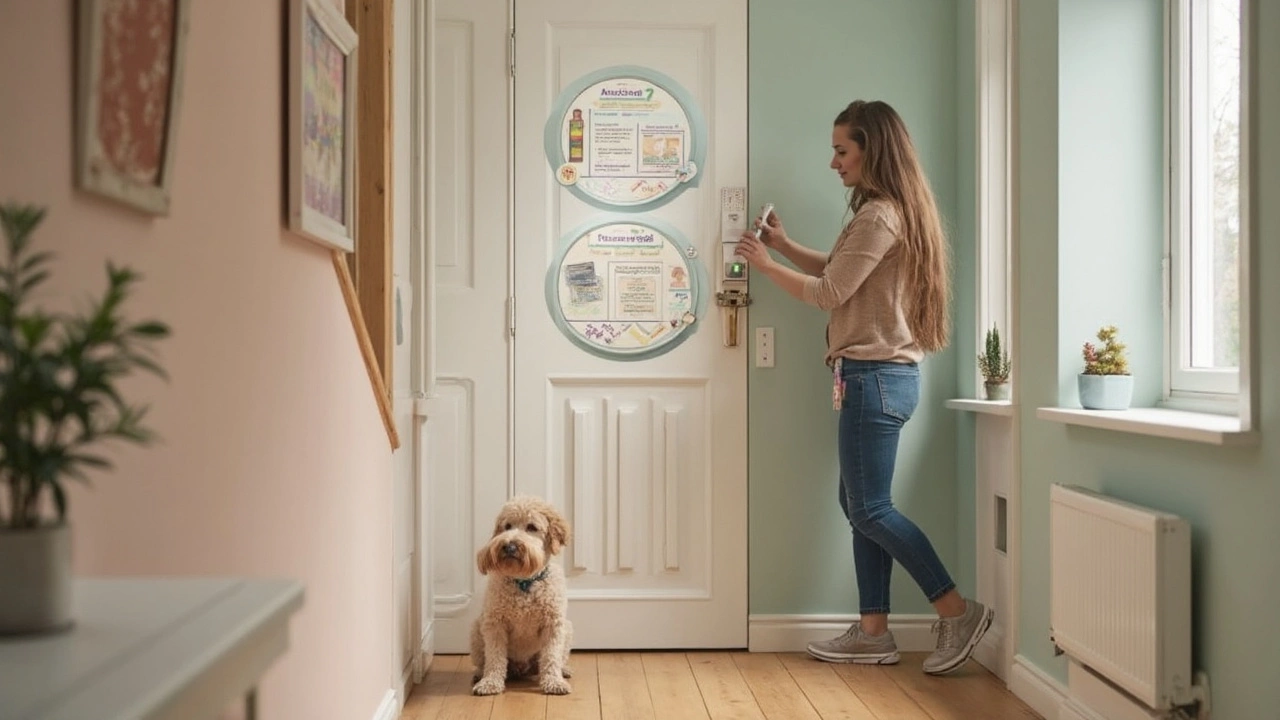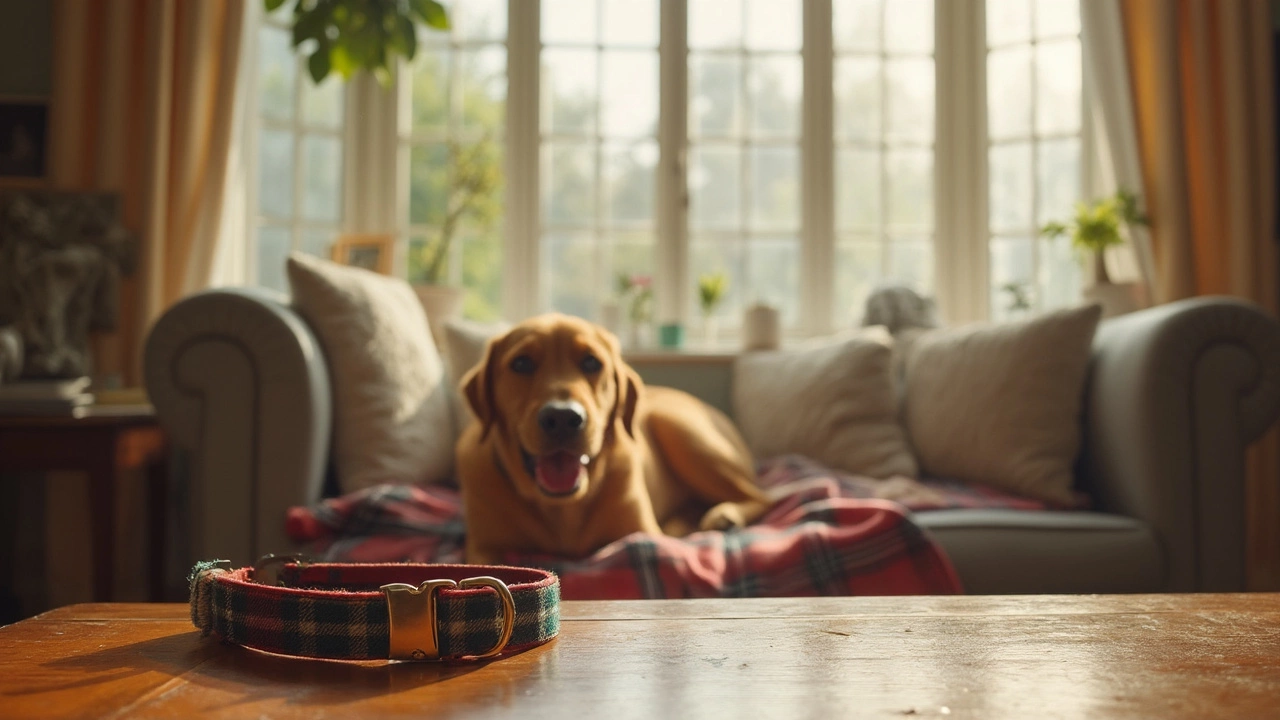Most people don't think twice about leaving their dog's collar on inside. It seems harmless, right? But collars can actually cause trouble at home, from accidents to weird injuries you probably never imagined.
If you’ve ever heard a sudden clatter and rushed in to see your dog caught on a crate or furniture, you know what I’m talking about. Collars snag on all sorts of things—couch corners, heat vents, crate bars. Dogs can panic and tug, which sometimes leads to choking, skin cuts, or even more serious stuff like broken teeth or jaws (yep, that really happens).
Besides, collars aren’t exactly the softest wear. Some dogs get skin irritation or lose fur where the collar sits—especially if it gets wet or dirty and stays on for days. Itchy, red skin is no fun, and it’s easy to miss if you’re not checking. Want your dog to relax and stretch out after a long walk? Taking that collar off at home feels better than you’d think.
- Hidden Hazards: Why Collars Can Be Risky Indoors
- Comfort First: Reducing Stress and Irritation
- What About ID Tags? Smart Alternatives
- Tips for a Safer, Happier Home
Hidden Hazards: Why Collars Can Be Risky Indoors
Leaving a dog collar on inside the house seems like no big deal, but accidents happen when you least expect them. The biggest concern is snagging. Collars get caught on crates, fences, door handles, or even those little metal parts on dog beds. Dogs panic in these moments—some pets have choked or suffered major injuries just from simple home stuff. Vets see it all the time. According to a survey by the Veterinary Medical Association, about 1 in 10 collar incidents at home result in injuries that need treatment. Crazy, right?
Another common danger: dogs playing together. If you have more than one dog, there’s a risk that jaws or paws get stuck under the other’s collar during roughhousing. This can quickly turn dangerous if nobody’s around to break it up. Stories about dogs getting their lower jaws stuck—ouch—are surprisingly common and can lead to trauma, dental damage, or even suffocation if you don’t catch it fast.
- Collars get tangled in crate bars and baby gates.
- Tags or buckles catch on heating vents and furniture.
- Multiple-dog households: collars get grabbed during play.
And here’s something to think about: collars can block airways or put pressure on neck vertebrae if they twist just right in a struggle. This can cause breathing trouble or long-term neck pain, sometimes without you noticing until the dog starts acting off.
Here’s quick data showing the types of collar-related accidents vets see most indoors:
| Type of Incident | % of Cases (Indoor) |
|---|---|
| Snagged on furniture/crate | 55% |
| Choking during play | 21% |
| Caught on heating vent or wire | 14% |
| Broken tooth or jaw | 6% |
| Other injuries | 4% |
These numbers might surprise you. Simply taking off the collar when your dog is safe at home knocks out most of these risks—easy win for you and your furry sidekick.
Comfort First: Reducing Stress and Irritation
Wearing a collar all day isn’t exactly comfy for your dog. Skin under a collar gets squished, rubbed, and sometimes overheats. It’s especially uncomfortable for breeds with sensitive skin or a lot of fluff, like Greyhounds or Huskies. If the collar’s too tight, it leaves marks or even sores. Too loose, and it still shifts around, causing even more friction. One small study actually found around 17% of dogs had injuries linked to their collars—usually from chafing, hair loss, or getting stuck.
Puppies and small breeds are even more likely to develop problems, because their skin is thin and collars don’t always fit just right as they grow. Picture your dog scratching their neck during shedding season—now add a collar trapping all that loose fur and dead skin. Not pleasant at all. Dogs don’t complain out loud, but signs like rubbing their face on the carpet or trying to scratch their collar area are easy to miss if you’re not looking.
| Issue | Possible Result |
|---|---|
| Constant friction | Skin irritation, redness |
| Tight collar | Hair loss, pressure sores |
| Dirty/wet collar | Fungal/bacterial infections |
| Allergic reaction | Itchy rash, swelling |
One easy fix—just use a collar for walks or outings and go collar-free at home. This gives your dog’s neck a break and lets you check for any bumps, redness, or bare patches you might miss otherwise. If you really want something on your dog for ID, a loose breakaway collar (like cat collars use) is way safer indoors. And here’s a tip: wash the collar every couple of weeks. That cuts down on skin troubles caused by grime or bacteria trapped against your dog’s skin.
When you focus on their comfort, dogs chill out. Less itching, less stress, less pacing. It’s a simple habit with a big payoff—all in the name of dog collars done right.

What About ID Tags? Smart Alternatives
Lots of people keep collars on their dogs 24/7 because they're nervous about losing their pet. An ID tag seems like the best way to get your furry friend home if they ever slip out the front door. But there are easier, safer ways to keep your dog identified without needing a dog collar on all the time.
First, let’s talk microchipping. Vets in the U.S. say more than 90% of shelters scan for microchips when they find a stray. Microchips are about the size of a grain of rice, aren’t visible, and can’t get lost like a collar and tag. You just need to keep your contact info updated with the chip company. It’s a near-foolproof backup if your dog ever pulls a Houdini.
There are also breakaway collars right for quick ID when you're out but safe at home. These snap open under pressure, so your dog won't get stuck if it snags on furniture or crates.
Want to keep ID info on your pup indoors, just in case? Try a flat, soft harness or a personalized bandana while you’re home. Some folks even use tags that attach to harnesses. If that sounds too much, consider a smart tag: you scan it with your phone for owner info in case the pup gets lost. And remember, the best security is making sure tricky doors, windows, and fences stay closed.
| Method | Lost-proof | Visible | Cost (Avg. USD) |
|---|---|---|---|
| Traditional Collar & Tag | No | Yes | $5-20 |
| Microchip | Yes | No | $25-50 |
| Breakaway Collar | No | Yes | $8-25 |
| Personalized Bandana | No | Yes | $10-15 |
| Smart Tag | No | Yes | $20-40 |
So, if you’re worried about losing indoor identification, you’ve got more choices than you might think—and none require risking your dog’s safety at home!
Tips for a Safer, Happier Home
If you want your dog to enjoy a comfy, safe life indoors, a little effort goes a long way. Here are some proven tricks for ditching the collar and keeping everyone chill around the house.
- Dog collars off when you come inside—seriously, it can be that simple. Stash a basket or hook near the door so you always remember to slip it on before heading out, especially if your pup is a runner.
- Try a breakaway or safety collar if you worry about quick getaways. These pop open under pressure, lowering the risk of choking if a collar does get snagged on furniture or a crate.
- If you’re nervous about losing your dog, grab a microchip from the vet. Chips are tiny, last for life, and most shelters and vets check for them first thing when a lost dog shows up.
- Treat your dog’s neck to regular checks. Look for redness, bare spots, or signs the fur is thinning, especially if you ever see your pup scratching. Clean the collar and your dog’s neck so gunk doesn’t build up and cause problems.
- Teach your family or roommates about the indoor collar rule. Kids especially need reminders not to yank or grab by the collar, since accidents can happen fast.
Want your dog’s ID handy at all times? You can always snap an AirTag or smart tag to a harness and let your pup wear that when you leave for a walk. Or get an embroidered collar for outdoors—those show your info without jingling tags.
In the end, your home is supposed to feel safe and chill for everyone, dogs included. Just a few changes and your buddy will be happier, safer, and way more relaxed indoors.
